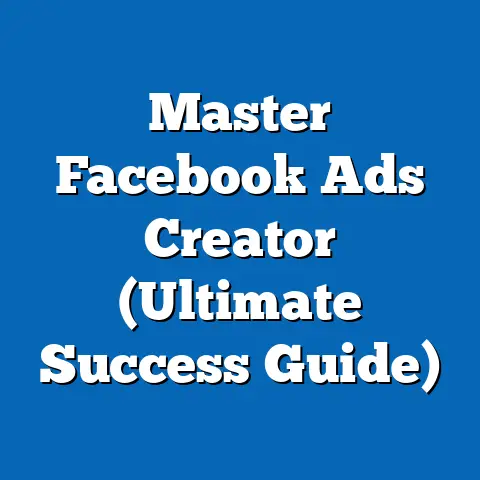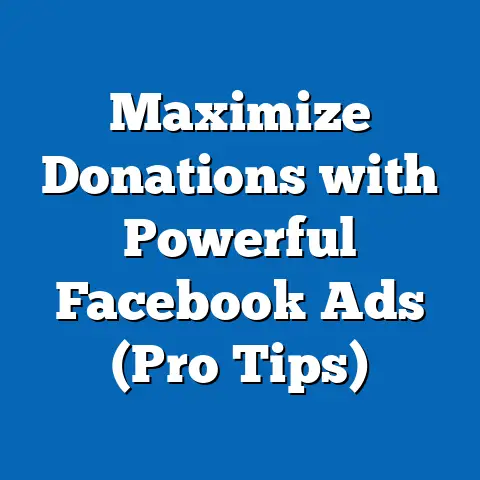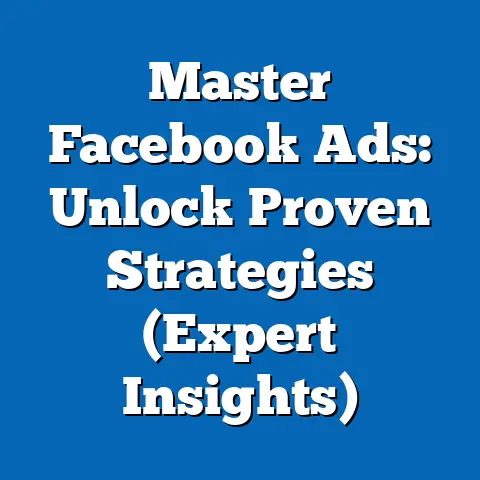Boost Clicks with Facebook Text Ads (Proven Tactics)
Remember the first time you saw an ad that truly grabbed your attention? Maybe it was a vibrant billboard on a family road trip, a catchy jingle on the radio, or even a simple, well-placed newspaper ad. Advertising has evolved so much since then, hasn’t it? We’ve gone from static images and catchy slogans to dynamic videos and interactive experiences. But amidst all the noise, sometimes the simplest approach can be the most effective. That’s where Facebook text ads come in.
Understanding Facebook Text Ads
Facebook text ads, in their simplest form, are advertisements that primarily rely on text to convey their message. Unlike image or video ads, which heavily depend on visual elements to capture attention, text ads use carefully crafted copy to engage users and prompt them to take action.
Key Differences:
- Visual Focus: Image and video ads rely heavily on visual appeal, while text ads prioritize concise and persuasive messaging.
- Attention Span: In a visually saturated environment, text ads can stand out by offering a refreshing alternative that demands less immediate attention.
- Creativity: Text ads challenge marketers to be creative with their words, crafting compelling copy that resonates with the target audience.
Unique Features:
- Character Limits: Facebook imposes character limits on headlines and body text, forcing marketers to be succinct and impactful in their messaging.
- Calls-to-Action (CTAs): Text ads often include CTAs that prompt users to take specific actions, such as “Learn More,” “Shop Now,” or “Sign Up.”
- Placement: Text ads can appear in various placements within the Facebook ecosystem, including the News Feed (though less common now), right column (desktop only), and within Facebook Marketplace.
The Power of Targeting:
One of the most significant advantages of Facebook text ads is their ability to be highly targeted. Facebook’s robust targeting options allow marketers to reach specific demographics, interests, behaviors, and even custom audiences based on their own customer data. This ensures that your text ads are seen by the people most likely to be interested in your product or service, maximizing their effectiveness.
Takeaway: Facebook text ads are a powerful tool when used strategically. While they might seem basic, their simplicity can be their strength, especially when combined with precise targeting.
Crafting Compelling Ad Copy
The heart of any successful Facebook text ad lies in its copy. This is where you have the opportunity to grab the user’s attention, convey your message, and inspire them to click. Writing persuasive ad copy is an art, and it requires a deep understanding of your target audience and the principles of effective communication.
Essential Components:
- Headline: The headline is the first thing users see, so it needs to be attention-grabbing and relevant. Aim for headlines that are concise, clear, and intriguing.
- Body Text: The body text provides additional details about your offer or message. Use this space to highlight the benefits of your product or service and explain why users should take action.
- Call-to-Action (CTA): The CTA tells users what you want them to do next. Use strong, action-oriented language that encourages clicks, such as “Shop Now,” “Learn More,” or “Get Started.”
Examples of High-Performing Ad Copy:
Let’s look at a few hypothetical examples:
-
Example 1: (For a local bakery)
- Headline: Craving Something Sweet?
- Body Text: Indulge in our freshly baked pastries and cakes. Made with love, every bite is pure bliss!
- CTA: Visit Us Today!
- Why it works: It uses a relatable feeling (craving something sweet), highlights the key benefit (freshly baked), and includes a direct CTA.
-
Example 2: (For a SaaS company)
- Headline: Stop Wasting Time on Spreadsheets!
- Body Text: Streamline your workflow with our intuitive project management software. Get organized and boost productivity.
- CTA: Start Your Free Trial!
- Why it works: It identifies a common pain point (wasting time), offers a solution (project management software), and provides a compelling CTA (free trial).
-
Example 3: (For an e-commerce store selling eco-friendly products)
- Headline: Shop Sustainably, Live Consciously
- Body Text: Discover eco-friendly products that are good for you and the planet. Make a difference with every purchase.
- CTA: Explore Our Collection!
- Why it works: It appeals to a specific value (sustainability), highlights the benefits (good for you and the planet), and invites exploration.
Example 1: (For a local bakery)
- Headline: Craving Something Sweet?
- Body Text: Indulge in our freshly baked pastries and cakes. Made with love, every bite is pure bliss!
- CTA: Visit Us Today!
- Why it works: It uses a relatable feeling (craving something sweet), highlights the key benefit (freshly baked), and includes a direct CTA.
Example 2: (For a SaaS company)
- Headline: Stop Wasting Time on Spreadsheets!
- Body Text: Streamline your workflow with our intuitive project management software. Get organized and boost productivity.
- CTA: Start Your Free Trial!
- Why it works: It identifies a common pain point (wasting time), offers a solution (project management software), and provides a compelling CTA (free trial).
Example 3: (For an e-commerce store selling eco-friendly products)
- Headline: Shop Sustainably, Live Consciously
- Body Text: Discover eco-friendly products that are good for you and the planet. Make a difference with every purchase.
- CTA: Explore Our Collection!
- Why it works: It appeals to a specific value (sustainability), highlights the benefits (good for you and the planet), and invites exploration.
Resonating with Your Audience:
The key to writing compelling ad copy is to understand your target audience and speak their language. Consider their demographics, interests, pain points, and aspirations. Use language that resonates with them and addresses their specific needs.
Tips for Tailoring Your Messaging:
Leveraging A/B Testing for Optimization
No matter how well you craft your ad copy, there’s always room for improvement. That’s where A/B testing comes in. A/B testing, also known as split testing, is a method of comparing two versions of an ad to see which one performs better.
The Importance of A/B Testing:
A/B testing allows you to make data-driven decisions about your ad copy, rather than relying on guesswork. By testing different variations of your ads, you can identify the elements that resonate most with your target audience and optimize your campaigns for maximum performance.
Step-by-Step Process:
- Choose a Variable to Test: Select one element of your ad copy to test, such as the headline, body text, or CTA. It’s important to test only one variable at a time so you can accurately attribute the results to that specific element.
- Create Two Versions of Your Ad: Create two versions of your ad, one with the original copy (the control) and one with the modified copy (the variation).
- Run Your Ads Simultaneously: Run both versions of your ad simultaneously to the same target audience. This will ensure that both ads are exposed to the same conditions and that the results are accurate.
- Track Your Results: Monitor the performance of both ads, paying attention to key metrics such as click-through rate (CTR), conversion rate, and cost per click (CPC).
- Analyze Your Results: After a sufficient amount of data has been collected, analyze the results to determine which version of your ad performed better.
- Implement the Winning Version: Implement the winning version of your ad into your campaign and continue testing other variables to further optimize performance.
Interpreting A/B Test Results:
When analyzing your A/B test results, it’s important to consider statistical significance. Statistical significance indicates whether the difference in performance between the two versions of your ad is likely due to chance or to the variable you tested.
Tips for Effective A/B Testing:
- Test One Variable at a Time: As mentioned earlier, testing only one variable at a time allows you to accurately attribute the results to that specific element.
- Test Significant Changes: Test changes that are likely to have a significant impact on performance. Small, incremental changes may not produce noticeable results.
- Run Your Tests Long Enough: Run your tests long enough to collect a sufficient amount of data. The longer you run your tests, the more accurate your results will be.
- Use a Control Group: Always include a control group in your tests. The control group represents the original version of your ad and serves as a benchmark against which to compare the performance of the variation.
- Document Your Tests: Keep a record of all your A/B tests, including the variables you tested, the results, and the conclusions you drew. This will help you learn from your tests and improve your future campaigns.
Takeaway: A/B testing is a continuous process. Don’t just run one test and call it a day. Continuously test and optimize your ad copy to achieve maximum performance.
Targeting the Right Audience
Even the most compelling ad copy will fall flat if it’s not seen by the right people. That’s why targeting is so crucial in Facebook advertising. Facebook offers a wide range of targeting options that allow you to reach specific demographics, interests, behaviors, and even custom audiences based on your own customer data.
Targeting Options:
- Demographics: Target users based on their age, gender, location, education, and other demographic factors.
- Interests: Target users based on their interests, hobbies, and passions.
- Behaviors: Target users based on their online and offline behaviors, such as their purchase history, travel habits, and device usage.
- Custom Audiences: Create custom audiences based on your own customer data, such as email lists, website visitors, and app users.
- Lookalike Audiences: Create lookalike audiences based on your custom audiences. Lookalike audiences are users who share similar characteristics and behaviors with your existing customers.
Strategies for Identifying and Segmenting Your Audience:
- Start with Your Ideal Customer: Create a detailed profile of your ideal customer, including their demographics, interests, behaviors, and pain points.
- Use Audience Insights: Facebook Audience Insights provides valuable data about your target audience, including their demographics, interests, and behaviors. Use this information to refine your targeting strategies.
- Segment Your Audience: Segment your audience based on their characteristics and behaviors. This will allow you to tailor your messaging and offers to specific groups of users.
- Test Different Targeting Options: Test different targeting options to see which ones perform best. Experiment with different demographics, interests, and behaviors to identify the most responsive segments of your audience.
The Importance of Audience Insights and Analytics:
Audience insights and analytics are essential for refining your targeting strategies and improving ad effectiveness. By monitoring the performance of your ads and analyzing the characteristics of the users who are responding to them, you can gain valuable insights into your target audience and optimize your campaigns accordingly.
Tips for Improving Your Targeting:
- Use Layered Targeting: Use layered targeting to narrow your audience and reach the most relevant users. For example, you could target users who are interested in both “yoga” and “meditation.”
- Exclude Irrelevant Audiences: Exclude irrelevant audiences from your targeting to avoid wasting your ad spend. For example, you could exclude users who have already purchased your product or service.
- Monitor Your Audience Overlap: Monitor the overlap between your different audiences to avoid targeting the same users multiple times.
- Use Lookalike Audiences Wisely: Use lookalike audiences to expand your reach and find new customers who are similar to your existing customers. However, be careful not to make your lookalike audiences too broad, as this can dilute their effectiveness.
Takeaway: Precise targeting is the bedrock of successful Facebook advertising. Understanding your audience and using Facebook’s targeting tools effectively will significantly improve your click-through rates and overall campaign performance.
Monitoring and Analyzing Performance
Running Facebook text ads is not a “set it and forget it” exercise. It requires ongoing monitoring and analysis to ensure that your ads are performing optimally. By tracking key metrics and analyzing your results, you can identify areas for improvement and optimize your campaigns for maximum effectiveness.
Key Metrics to Track:
- Click-Through Rate (CTR): CTR measures the percentage of users who click on your ad after seeing it. A high CTR indicates that your ad copy is compelling and relevant to your target audience.
- Conversion Rate: Conversion rate measures the percentage of users who take a desired action after clicking on your ad, such as making a purchase, signing up for a newsletter, or filling out a form. A high conversion rate indicates that your ad is effectively driving conversions.
- Cost Per Click (CPC): CPC measures the average cost you pay each time someone clicks on your ad. A low CPC indicates that your ad is efficient and cost-effective.
- Cost Per Acquisition (CPA): CPA measures the average cost you pay to acquire a new customer. A low CPA indicates that your ad is effectively driving customer acquisition.
- Return on Ad Spend (ROAS): ROAS measures the revenue you generate for every dollar you spend on advertising. A high ROAS indicates that your ad is profitable and generating a positive return on investment.
Using Facebook Insights and Ads Manager:
Facebook Insights and Ads Manager provide valuable tools for monitoring ad performance and gathering analytics.
- Facebook Insights: Facebook Insights provides data about your target audience, including their demographics, interests, behaviors, and engagement with your ads.
- Ads Manager: Ads Manager allows you to track the performance of your ads, including key metrics such as CTR, conversion rate, CPC, and CPA.
Tips for Continuous Improvement:
- Set Goals and Track Progress: Set clear goals for your campaigns and track your progress towards those goals. This will help you stay focused and motivated.
- Analyze Your Results Regularly: Analyze your results regularly to identify areas for improvement. Look for patterns and trends in your data.
- Test New Ideas: Don’t be afraid to experiment with new ideas. Test different ad copy, targeting options, and bidding strategies to see what works best.
- Stay Up-to-Date: Stay up-to-date with the latest Facebook advertising features and best practices. Facebook is constantly evolving, so it’s important to stay informed.
- Learn from Your Mistakes: Everyone makes mistakes. The key is to learn from your mistakes and use them as opportunities for growth.
Takeaway: Monitoring and analyzing your ad performance is crucial for continuous improvement. Use Facebook Insights and Ads Manager to track key metrics, analyze your results, and optimize your campaigns for maximum effectiveness.
The Future of Facebook Text Ads
The digital advertising landscape is constantly evolving, and Facebook text ads are no exception. While visual content continues to dominate, the power of concise, well-crafted messaging remains relevant. I believe that text ads will continue to play a valuable role in the marketing mix, especially when combined with innovative targeting techniques and a focus on delivering personalized experiences.
Potential Future Trends:
- Increased Personalization: As Facebook continues to collect more data about its users, we can expect to see even more personalized text ads that are tailored to individual interests and preferences.
- AI-Powered Optimization: Artificial intelligence (AI) is already playing a significant role in Facebook advertising, and we can expect to see even more AI-powered optimization tools in the future. These tools will help marketers automate tasks, improve targeting, and optimize ad copy.
- Integration with Other Platforms: Facebook is increasingly integrating its advertising platform with other platforms, such as Instagram and WhatsApp. This will allow marketers to reach a wider audience and deliver more seamless experiences.
- Focus on Value and Authenticity: As users become more discerning about the ads they see, there will be an even greater focus on delivering value and authenticity. Ads that are perceived as spammy or irrelevant will be ignored.
Embrace the Power of Facebook Text Ads:
Facebook text ads are a dynamic tool in your marketing arsenal. With proven tactics and a strategic approach, you can significantly enhance your click-through rates and overall campaign success. Don’t underestimate the power of simplicity and precision in a world saturated with visual noise.
Call to Action:
I encourage you to experiment with the tactics discussed in this guide and share your experiences and results. Stay updated with the latest developments in Facebook advertising to stay ahead of the curve. The future of Facebook text ads is bright, and with a little creativity and effort, you can harness their potential to achieve remarkable results.






